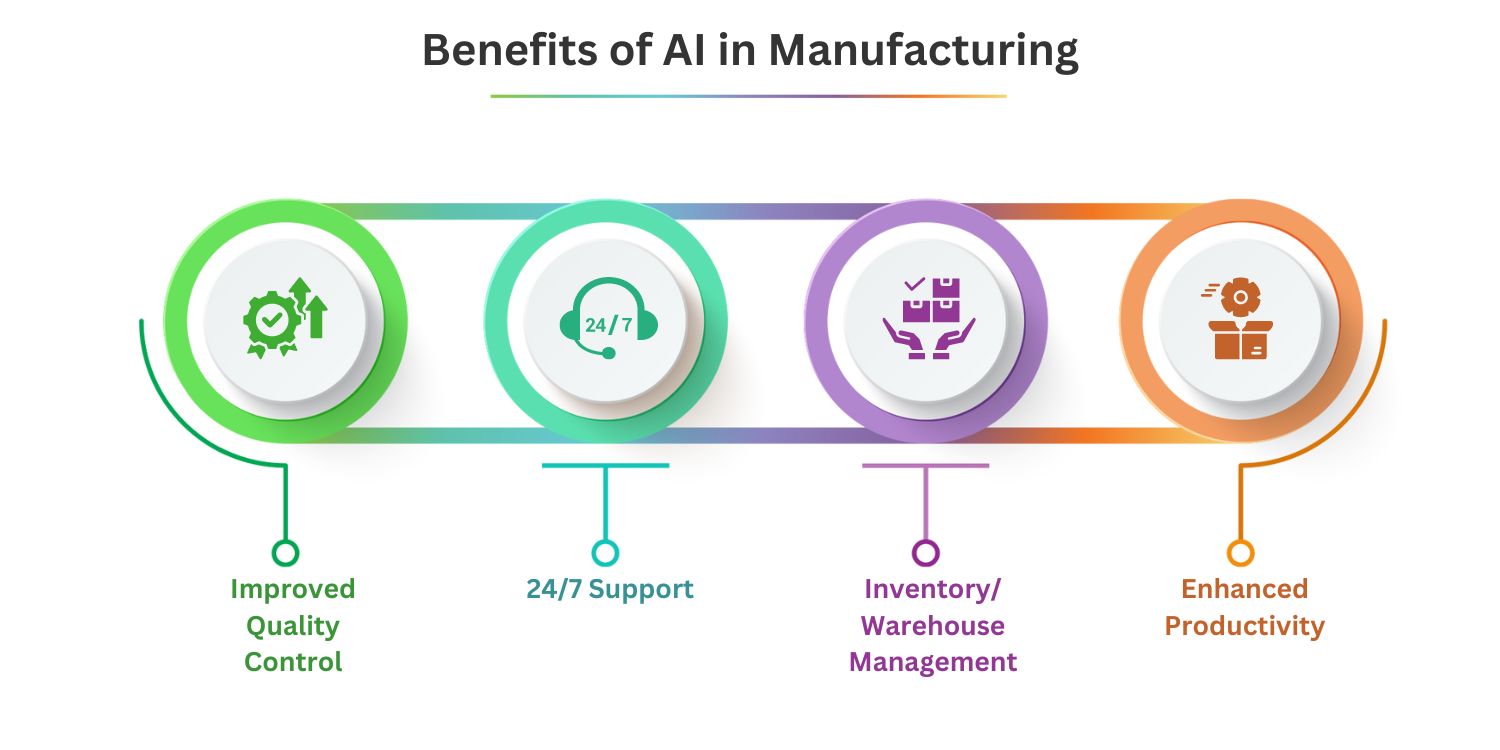The pressure to improve productivity is mounting in the manufacturing sector. Rising costs, supply chain disruptions, and labor shortages are driving companies to seek new ways to get more done with less. artificial intelligence (umělá intelligence) has emerged as a game-changer in this quest for efficiency. By harnessing the power of AI, manufacturers can streamline operations, reduce downtime, and optimize resource usage.
In this article, we’ll explore the key benefits of AI in manufacturing and how companies can leverage these technologies to boost efficiency, cut costs, and remain competitive in an increasingly challenging market.
Understanding AI and Its Applications in Manufacturing
Before we can explore how AI can enhance efficiency in manufacturing, it’s essential to understand what AI is and how it’s currently being used in the industry.
What is AI?
Artificial intelligence refers to the ability of machines to learn, reason, and make decisions like humans. This includes technologies like machine learning (ML), which enables systems to improve their performance over time as they gather more data, and natural language processing (NLP), which allows machines to understand and respond to human language.
Current Applications of AI in Manufacturing
In recent years, manufacturers have begun to adopt AI solutions across various areas of their operations. Some of the most common applications include:
- Predictive maintenance
- Quality control
- Supply chain optimization
- Robotics and automation
- Demand forecasting
The Importance of AI in Today’s Manufacturing Landscape
The adoption of AI in manufacturing is no longer just a trend; it’s becoming a necessity. According to a report from McKinsey, companies that effectively use AI could potentially boost their profitability by 38% by 2035. In light of these statistics, it’s crucial for manufacturers to understand the benefits of adopting AI technologies and how they can integrate these solutions into their operations.
Streamlining Operations with AI
One of the primary ways AI can improve efficiency in manufacturing is by streamlining operations. By automating repetitive tasks, AI systems allow human workers to focus on more value-added activities, ultimately improving overall productivity.
Automation of Repetitive Tasks
Many manufacturing processes involve repetitive tasks that can be automated with the help of AI. For example, AI-powered robotic arms can be programmed to perform assembly line tasks such as screw fastening or welding with greater precision than human workers. The implementation of these technologies not only reduces the risk of human error but also increases the speed and consistency of production.
Intelligent Workflow Management
In addition to automating physical tasks, AI can also enhance workflow management in manufacturing operations. Through machine learning algorithms, AI systems can analyze data from various sources (e.g., production schedules, machine performance, and resource availability) to create intelligent workflows that optimize resource allocation and minimize bottlenecks. By using these intelligent workflows, manufacturers can ensure that their production lines run smoothly and efficiently, ultimately leading to higher output and reduced lead times.
Overall Impact on Productivity and Cost Reduction
By streamlining operations through automation and intelligent workflow management, manufacturers can significantly improve their productivity levels and reduce operational costs. According to a study by PwC, 72% of business leaders believe that AI will be the business advantage of the future, and 54% of executives said that they would adopt AI to boost operational efficiency. These statistics demonstrate that manufacturers who invest in AI technology stand to gain a competitive edge in an increasingly complex market.
Reducing Downtime with Predictive Maintenance
Another significant benefit of AI in manufacturing is its ability to reduce downtime through predictive maintenance.
The Challenge of Unplanned Downtime
Unplanned downtime is a significant issue for manufacturers, costing them millions of dollars each year. For instance, a study by the International Society of Automation (ISA) found that unplanned downtime can cost manufacturers approximately $260,000 per hour. This figure underlines the importance of effective maintenance strategies.
How AI Enables Predictive Maintenance
AI-powered predictive maintenance solutions use machine learning algorithms to analyze data from sensors embedded in machines and equipment. By monitoring parameters like temperature, vibration, and sound, these systems can detect patterns that indicate when a machine is likely to fail. This predictive capability allows manufacturers to schedule maintenance activities before a breakdown occurs, minimizing disruptions to production.
Case Study – AI in Predictive Maintenance
Several manufacturers have successfully implemented AI-driven predictive maintenance strategies, resulting in significant reductions in downtime and maintenance costs. For example, Siemens has leveraged AI technologies to enhance the predictive maintenance capabilities of its customers’ industrial machinery. According to Siemens, this approach has enabled their clients to achieve a 20% reduction in unplanned downtime and a 10% decrease in maintenance costs.
Optimizing Resource Usage with AI
AI can also play a vital role in optimizing resource usage in manufacturing operations, leading to more efficient production processes and reduced waste.
The Importance of Efficient Resource Usage
Efficient resource usage is crucial for manufacturers looking to improve their bottom line and minimize their environmental impact. According to a report from the World Economic Forum, improving resource efficiency could potentially save the manufacturing industry $1.2 trillion per year by 2030. AI technologies offer several ways to optimize resource usage in manufacturing operations.
AI-Driven Supply Chain Optimization
AI can significantly enhance supply chain efficiency by analyzing vast amounts of data from various sources (e.g., production schedules, inventory levels, and supplier performance) to identify patterns and trends. For instance, AI systems can forecast demand for specific products, enabling manufacturers to adjust their production schedules and inventory levels accordingly. By implementing AI-driven supply chain optimization strategies, manufacturers can reduce excess inventory and improve order fulfillment rates, ultimately leading to increased customer satisfaction and lower operational costs.
Energy Management
Manufacturers can also leverage AI technologies to monitor and manage energy consumption in their facilities. For example, AI-powered energy management systems can analyze data from sensors embedded in machines and equipment to identify patterns in energy usage. By understanding these patterns, manufacturers can implement strategies to reduce energy consumption during peak periods, leading to lower energy costs and a reduced carbon footprint.
Waste Reduction
AI technologies can also assist manufacturers in minimizing waste during production processes. For example, machine learning algorithms can analyze historical production data to identify patterns that lead to waste generation (e.g., excessive scrap material or defective products). By understanding these patterns, manufacturers can make adjustments to their production processes, ultimately reducing waste and improving overall resource efficiency.
Enhancing Quality Control with AI
AI can also play a critical role in enhancing quality control processes in manufacturing, leading to improved product quality and reduced defects.
Traditional Quality Control Challenges
Traditional quality control methods often rely on manual inspection or statistical sampling, which can be time-consuming and prone to human error. According to a report from the American Society for Quality (ASQ), the cost of poor quality in manufacturing can range from 15% to 30% of total production costs. This figure highlights the need for more effective quality control strategies.
AI-Driven Quality Control Solutions
AI technologies, particularly computer vision, can significantly improve the accuracy and efficiency of quality control processes. AI-powered inspection systems utilize cameras and machine learning algorithms to analyze products in real-time, identifying defects or deviations from quality standards with greater precision than human inspectors. For instance, companies like Amazon and Tesla have successfully implemented AI-driven quality control solutions, resulting in improved product quality and reduced defect rates.
Case Study – AI in Quality Control
In a notable case, a leading automotive manufacturer leveraged AI technologies to enhance its quality control processes. By implementing an AI-powered inspection system, the company achieved a 90% reduction in defective products and a 50% decrease in inspection costs. This success story demonstrates the potential impact of AI-driven quality control solutions on overall product quality and manufacturing efficiency.
Conclusion
The manufacturing sector is facing unprecedented challenges, from rising costs to supply chain disruptions and increasing competition. In this context, the adoption of AI technologies has emerged as a crucial strategy for manufacturers looking to boost efficiency and remain competitive. By streamlining operations, reducing downtime through predictive maintenance, optimizing resource usage, and enhancing quality control, AI has the potential to transform the way manufacturers operate.
As manufacturers begin to explore the possibilities offered by AI, it’s essential for them to partner with experienced AI providers and invest in the necessary infrastructure to support these technologies. By doing so, they can unlock the full potential of AI and position themselves for success in an increasingly complex and competitive marketplace.



